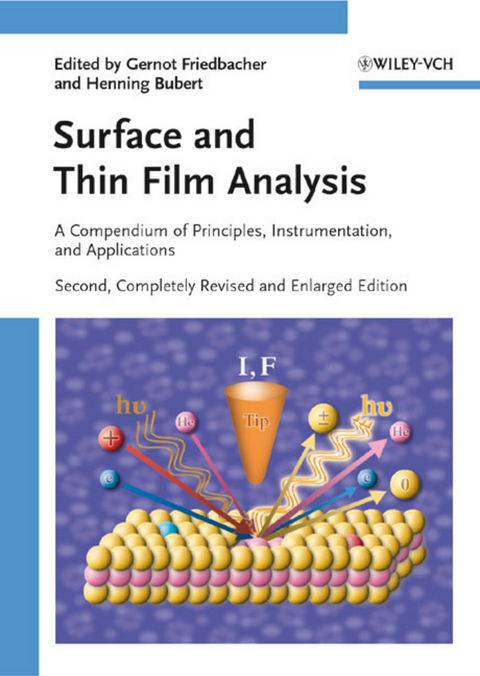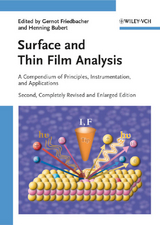Surface and Thin Film Analysis
Wiley-VCH (Verlag)
978-3-527-32047-9 (ISBN)
Surveying and comparing all techniques relevant for practical applications in surface and thin film analysis, this second edition of a bestseller is a vital guide to this hot topic in nano- and surface technology. This new book has been revised and updated and is divided into four parts - electron, ion, and photon detection, as well as scanning probe microscopy. New chapters have been added to cover such techniques as SNOM, FIM, atom probe (AP),and sum frequency generation (SFG). Appendices with a summary and comparison of techniques and a list of equipment suppliers make this book a rapid reference for materials scientists, analytical chemists, and those working in the biotechnological industry.From a Review of the First Edition (edited by Bubert and Jenett)"... a useful resource..."(Journal of the American Chemical Society)
Gernot Friedbacher is Associate Professor of Analytical Chemistry at the Vienna University of Technology. His research activities are focused on investigation of surfaces and surface processes with scanning probe microscopy and electron probe x-ray microanalysis covering a broad field of applications ranging from basic research on thin film systems to materials science. Over the last decades he has held numerous theoretical and practical courses in the field of analytical chemistry with emphasis on intstrumental analysis and surface- and interface analysis. Prof. Friedbacher has published over 120 research articles, reviews, and book chapters. Henning Bubert worked at the Institut für Analytische Wissenschaften - ISAS - (Institute for Analytical Sciences) in Dortmund until his retirement in 2003. He is currently working as guest scientist. His research activities are mainly focused on investigation of surfaces and thin films by electron spectroscopy related to the development and application of new materials in mechanical engineering. He has published over 110 research articles, reviews, and book chapters.
Preface
INTRODUCTION
PART I: Electron Detection
X-RAY PHOTOELECTRON SPECTROSCOPY (XPS)
Principles
Instrumentation
Spectral Information and Chemical Shifts
Quantification, Depth Profiling, and Imaging
The Auger Parameter
Applications
Ultraviolet Photoelectron Spectroscopy (UPS)
AUGER ELECTRON SPECTROSCOPY (AES)
Principles
Instrumentation
Spectral Information
Quantification and Depth Profiling
Applications
Scanning Auger Microscopy (SAM)
ELECTRON ENERGY-LOSS SPECTROSCOPY (EELS) AND ENERGY-FILTERING TRANSMISSION ELECTRON MICROSCOPY (EFTEM)
Principles
Instrumentation
Qualitative Spectral Information
Quantification
Imaging of Element Distribution
Summary
LOW-ENERGY ELECTRON DIFFRACTION (LEED)
Principles and History
Qualitative Information
Quantitative Structural Information
Low-Energy Electron Microscopy
OTHER ELECTRON-DETECTING TECHNIQUES
Ion (Excited) Auger Electron Spectroscopy (IAES)
Ion Neutralization Spectroscopy (INS)
Inelastic Electron Tunneling Spectroscopy (IETS)
PART II: Ion Detection
STATIC SECONDARY ION MASS SPECTROMETRY (SSIMS)
Principles
Instrumentation
Quantification
Spectral Information
Applications
DYNAMIC SECONDARY ION MASS SPECTROMETRY (SIMS)
Principles
Instrumentation
Spectral Information
Quantification
Mass Spectra
Depth Profiles
Imaging
Three-Dimensional (3-D)-SIMS
Applications
ELECTRON-IMPACT (EI) SECONDARY NEUTRAL MASS SPECTROMETRY (SNMS)
Introduction
General Principles of SNMS
Instrumentation and Methods
Spectral Information and Quantification
Element Depth Profiling
Applications
LASER SECONDARY NEUTRAL MASS SPECTROMETRY (LASER-SNMS)
Principles
Instrumentation
Spectral Information
Quantification
Applications
RUTHERFORD BACKSCATTERING SPECTROSCOPY (RBS)
Introduction
Principles
Instrumentation
Spectral Information
Quantification
Figures of Merit
Applications
Related Techniques
LOW-ENERGY ION SCATTERING (LEIS)
Principles
Instrumentation
LEIS Information
Quantification
Applications of LEIS
ELASTIC RECOIL DETECTION ANALYSIS (ERDA)
Introduction
Fundamentals
Particle Identification Methods
Equipment
Data Analysis
Sensitivity and Depth Resolution
Applications
NUCLEAR REACTION ANALYSIS (NRA)
Introduction
Principles
Equipment and Depth Resolution
Applications
FIELD ION MICROSCOPY (FIM) AND ATOM PROBE (AP)
Introduction
Principles and Instrumentation
Applications
OTHER ION-DETECTING TECHNIQUES
Desorption Methods
Glow-Discharge Mass Spectroscopy (GD-MS)
Fast-Atom Bombardment Mass Spectroscopy (FABMS)
PART III: Photon Detection
TOTAL-REFLECTION X-RAY DLUORESCENCE (TXRF) ANALYSIS
Principles
Instrumentation
Spectral Information
Quantification
Applications
ENERGY-DISPERSIVE X-RAY SPECTROSCOPY (EDXS)
Principles
Practical Aspects of X-Ray Microanalysis and Instrumentation
Qualitative Spectral Information
Quantification
Imaging and Element Distribution
Summary
GRAZING INCIDENCE X-RAY METHODS FOR NEAR-SURFACE STRUCTURAL STUDIES
Principles
Experimental Techniques and Data Analysis
Applications
GLOW DISCHARGE OPTICAL EMISSION SPECTROSCOPY (GD-OES)
Principles
Instrumentation
Spectral Information
Quantification
Depth Profiling
Applications
SURFACE ANALYSIS BY LASER ABLATION
Introduction
Instrumentation
Depth Profiling
Near-Field Ablation
Conclusion
ION BEAM SPECTROCHEMICAL ANALYSIS (IBSCA)
Principles
Instrumentation
Spectral and Analytical Information
Quantitative Analysis by IBSCA
Applications
REFLECTION ABSORPTION IR SPECTROSCOPY (RAIRS)
Instrumentation
Principles
Applications
Related Techniques
SURFACE RAMAN SPECTROSCOPY
Principles
Surface-Enhanced Raman Scattering (SERS)
Instrumentation
Spectral Information
Quantification
Applications
Nonlinear Optical Spectroscopy
UV-VIS-IR ELLIPSOMETRY (ELL)
Principles
Instrumentation
Applications
SUM FREQUENCY GENERATION (SFG) SPECTROSCOPY
Introduction to SFG Spectroscopy
SFG Theory
SFG Instrumentation and Operation Modes
Applications of SFG Spectroscopy and Selected Case Studies
Conclusion
OTHER PHOTON-DETECTING TECHNIQUES
Appearance Potential Methods
Inverse Photoemission Spectroscopy (IPES) and Bremsstrahlung
PART IV: Scanning Probe Microscopy
INTRODUCTION
ATOMIC FORCE MICROSCOPY (AFM)
Principles
Further Modes of AFM Operations
Instrumentation
Applications
SCANNING TUNNELING MICROSCOPY (STM)
Principles
Instrumentation
Lateral and Spectroscopy Information
Applications
SCANNING NEAR-FIELD OPTICAL MICROSCOPY (SNOM)
Introduction
Instrumentation and Operation
SNOM Applications
Outlook
APPENDIX
Summary and Comparison of Techniques
Surface and Thin-Film Analytical Equipment Suppliers
"...a useful resource..." Journal of the American Chemical Society
"...a useful resource..." Journal of the American Chemical Society
| Erscheint lt. Verlag | 20.4.2011 |
|---|---|
| Sprache | englisch |
| Maße | 170 x 240 mm |
| Gewicht | 1200 g |
| Themenwelt | Naturwissenschaften ► Chemie ► Analytische Chemie |
| Schlagworte | Analytical Chemistry • Analytische Chemie • Chemie • Chemie / Theoretische Chemie • Chemische Analyse • Chemistry • Dünne Schicht • Dünne Schichten, Oberflächen u. Grenzflächen • Dünnschichttechnologie • materials characterization • Materials Science • Materialwissenschaften • Oberfläche • Oberflächenanalyse • spectroscopy • Spektroskopie • Thin Films, Surfaces & Interfaces • Thin Films, Surfaces & Interfaces • Werkstoffprüfung |
| ISBN-10 | 3-527-32047-4 / 3527320474 |
| ISBN-13 | 978-3-527-32047-9 / 9783527320479 |
| Zustand | Neuware |
| Informationen gemäß Produktsicherheitsverordnung (GPSR) | |
| Haben Sie eine Frage zum Produkt? |
aus dem Bereich




